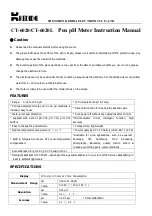
Using, Creating and Editing the
A
uto
Accompaniment Styles
Style Creator
CVP-409/407 Owner’s Manual
128
2
Use the [1
π
π
π
π†
†
†
†
]/[2
π
π
π
π†
†
†
†
] (CHANNEL) buttons to select the channel to
be edited.
The selected channel is shown at the upper left of the display.
3
Use the [3
π
π
π
π†
†
†
†
]–[8
π
π
π
π†
†
†
†
] buttons to edit the data.
For details on editable parameters, see below.
4
Press the [I] (SAVE) button to call up the Style Selection display to
save your data.
Save the data in the Style Selection display (page 69).
■
SOURCE ROOT/CHORD
These settings determine the original key of the source pattern (i.e., the key used
when recording the pattern). The default setting of CM7 (with a Source Root of “C”
and a Source Type of “M7”), is automatically selected whenever the preset data is
deleted prior to recording a new Style, regardless of the Source Root and Chord
included in the preset data. When you change Source Root/Chord from the default
CM7 to another chord, the chord notes and recommended notes will also change,
depending on the newly selected chord type.
When the Source Root is C:
■
NTR (Note Transposition Rule)
This determines the relative position of the root note in the chord, when converted
from the Source Pattern in response to chord changes.
CAUTION
The edited Style will be lost if
you change to another Style
or you turn the power off
without executing the Save
operation.
Auditioning Your Style with a
Specific Chord
Normally in the Style Creator,
you can hear your original Style-
in-process with the Source Pat-
tern. However, there is a way to
hear it played by a specific chord
and root. To do this, set NTR to
“Root Fixed,” NTT to “Bypass,”
and NTT BASS to “OFF” then
change the newly displayed
“Play Root” and “Play Chord”
parameters to the desired set-
tings.
ROOT TRANS
(Root Transpose)
When the root note is transposed, the
pitch relationship between notes is
maintained. For example, the notes
C3, E3 and G3 in the key of C become
F3, A3 and C4 when they are trans-
posed to F. Use this setting for chan-
nels that contain melody lines.
ROOT FIXED
The note is kept as close as possible to
the previous note range. For example,
the notes C3, E3 and G3 in the key of
C become C3, F3 and A3 when they
are transposed to F. Use this setting for
channels that contain chord parts.
C R
C
R
C
Cm
C R
C C
R
C
Cm
6
C
C
R
C
C
Cm
7
C
R
R
R
C
C
C
Cm
b
5
7
C C
R C
C
C
7
Cm
(9)
C R
C
C
C
C
7
Cm
(11)
C R
C
C
R
C
CmM
7
C C
R C
C
Cm
(9)
C
C
C
C
7
C
C C
R C
C
C
7
CmM
(9)
C
R
C
C R
Cdim
C R
R
R
C
C
C R
Cdim
7
C C C
C
C
C
(9)
7
C R C
C
C
C
b
5
7
C R C
C R
C
C
C
(
#
11
)
7
C
C
C
C
C sus
4
7
C R C
C R
CM
C R C
C
C
R
CM
7
C C C
C
C
R
7
CM
(9)
C C C
C
R
C
C
(9)
6
C R C
R C R
Caug
C R C
C
R
C
CM
6
C R C
C
C
R
C
7
CM
(
#
11)
C C C
C R
CM
add9
C R C
C C
C
C
(13)
7
C
C
C
C
C
C
(
b
9)
7
C
C
1+8
C
C
C
1+5
C
C
C
R
C
C
C
(
#
9)
7
C R C
R C C
C aug
7
C R C
C
R
R
C
CM aug
7
C
C
C
R
R
C C
C
(
b
13
)
7
C R
C
C
Csus
4
C C R
C R
Csus
2
C = Chord notes C, R = Recommended notes
When playing a
C major chord.
When playing an F
major chord.
When playing a C
major chord.
When playing an
F major chord.
















































